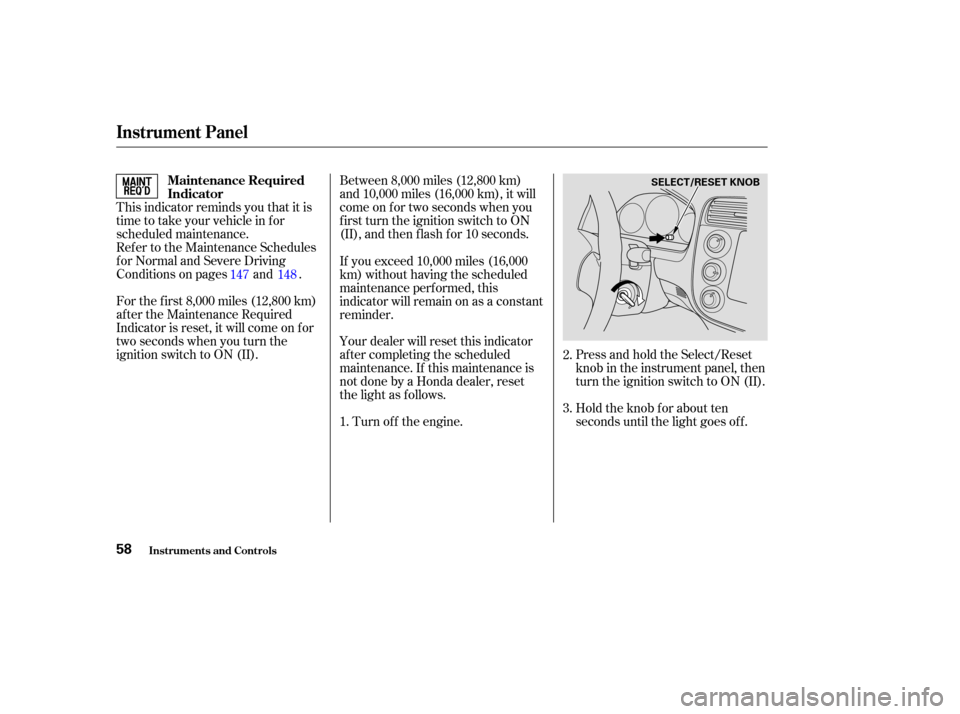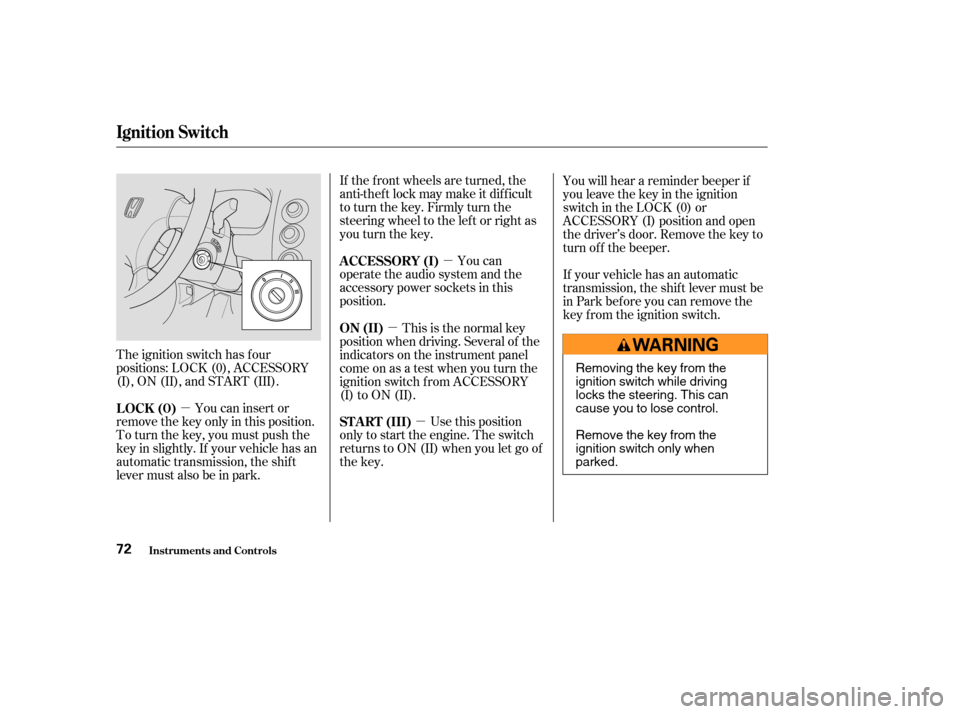Page 61 of 231

Between 8,000 miles (12,800 km)
and 10,000 miles (16,000 km), it will
come on f or two seconds when you
f irst turn the ignition switch to ON
(II), and then f lash f or 10 seconds.
This indicator reminds you that it is
time to take your vehicle in for
scheduled maintenance.
Ref er to the Maintenance Schedules
f or Normal and Severe Driving
Conditions on pages and .
For the f irst 8,000 miles (12,800 km)
af ter the Maintenance Required
Indicator is reset, it will come on f or
two seconds when you turn the
ignition switch to ON (II).
Your dealer will reset this indicator
af ter completing the scheduled
maintenance. If this maintenance is
not done by a Honda dealer, reset
the light as f ollows. Press and hold the Select/Reset
knob in the instrument panel, then
turn the ignition switch to ON (II).
Hold the knob f or about ten
seconds until the light goes of f .
Turn of f the engine.
If you exceed 10,000 miles (16,000
km) without having the scheduled
maintenance perf ormed, this
indicator will remain on as a constant
reminder.
1.
2.
3.
147 148
Inst rument s and Cont rols
Maintenance Required
Indicator
Instrument Panel
58
SELECT/RESET KNOB
Page 64 of 231
You can temporarily turn of f the
Current Fuel Mileage display.This shows how much f uel you have.
It may show slightly more or less
than the actual amount.
Turn the ignition switch to ON (II)
and make sure the transmission is
in Neutral (manual) or Park
(automatic) and the parking brake
is set.
Use the Select/Reset button to
select the odometer display.
Press and hold the Select/Reset
button f or about 10 to 15 seconds,
then release it. The Current Fuel
Mileage display will turn of f .
The display will turn back on when
you repeat the same procedure in
step 3. 1.
3. 2.
Gauges
Inst rument s and Cont rols
T urning Of f the Mileage Display Fuel Gauge
61
Avoid driving with an extremely low
f uel level. Running out of f uel could
cause the engine to misf ire, damaging
the catalytic converter.
Page 67 of 231
Controls Near the Steering Wheel
Inst rument s and Cont rols64
MIRROR CONTROLSHEADLIGHTS/
TURN SIGNALS
CRUISE CONTROL
SWITCHES
WINDSHIELD
WIPERS/WASHERS
REAR WINDOW
DEFOGGER ECON BUTTON
CRUISE CONTROL
MASTER SWITCH
STEERING WHEEL
ADJUSTMENT HAZARD WARNING
BUTTON
HORN
Page 69 of 231

�µ�µ�µ
Push down on the
lef t lever to signal a lef t turn and up
to signal a right turn. To signal a lane
change, push lightly on the lever and
hold it. The lever will return to
center when you release it or
complete a turn. To turn on, push
the lever f orward until you hear a
click. The blue high beam indicator
will light (see page ). Pull it back
to return to low beams. To flash the
high beams, pull the lever back
lightly, then release it. The high
beams will stay on as long as you
hold the lever back.
The headlights revert to normal
operation when you turn them on
with the switch.
Rotating switch
on the lef t lever controls to the
‘‘ ’’ position turns on the parking
lights, taillights, instrument panel
lights, side-marker lights, and rear
license plate lights. Turning the
switch to the ‘‘ ’’ position turns
on the headlights. If you leave the
lights on with the ignition switch in
ACCESSORY (I) or LOCK (0), you
will hear a reminder tone when you
open the driver’s door. With the headlight switch off, the
high beam headlights come on with
reduced brightness when you turn
the ignition switch to ON (II) and
release the parking brake. They
remain on until you turn the ignition
of f , even if you set the parking brake.
Turn Signal
Of f
Parking and interior lights
Headlight on
High beams
Flashhighbeams
1.
2.
3.
4.
5.
6. 56
Canadian models only
Turn Signal
High Beams
Daytime Running L ights
Headlights On
Turn Signal and Headlights
Inst rument s and Cont rols66
Page 70 of 231

Push the button between the center
vents to turn on the hazard warning
lights (f our-way f lashers). This
causes all f our outside turn signals
and both indicators in the instrument
panel to f lash. Use the hazard
warning lights if you need to park in
a dangerous area near heavy traffic,
or if your vehicle is disabled.
The knob on the instrument panel
controls the brightness of the instru-
ment panel lights. Turn the knob to
adjust the brightness.
When you turn the knob, the
odometer/trip meter display
changes to circles that show you the
current level. You will hear a tone
when you reach the maximum or
minimum brightness. The display
returns to the odometer/trip meter values f ive seconds af ter you stop
adjusting the knob.
Adjust the brightness to the desired
level with the headlight switch of f ,
and also with the headlight switch on.
To reduce glare at night, the
instrument panel illumination dims
when you turn the light switch to
or . Turning the Select/
Reset knob f ully to the right will
return the instrument panel to the
brightness adjusted with the
headlight switch of f and a tone will
sound.
Instrument Panel Brightness
Hazard Warning Button
Instrument Panel Brightness, Hazard Warning Button
Inst rument s and Cont rols67
KNOB
Page 71 of 231
Make sure the rear window is clear
and you have good visibility bef ore
starting to drive.
The def ogger and antenna wires on
the inside of the rear window can be
accidentally damaged. When
cleaning the glass, always wipe side
to side.
The rear window def ogger will clear
fog,frost,andthinicefromthe
window. Push the def ogger button to
turn it on and of f . The light in the
button lights to show the def ogger is
on. If you do not turn it of f , the
def ogger will shut itself of f af ter
about15minutes.Italsoshutsoff
when you turn of f the ignition. You
have to turn it on again when you
restart the vehicle.
Rear Window Def ogger
Inst rument s and Cont rols68
Page 73 of 231
Youshouldhavereceivedakey
number tag with your set of keys.
You will need this key number if you
ever have to get a key replaced. Use
only Honda-approved key blanks.These keys contain electronic
circuits that are activated by the
Immobilizer System. They will not
work to start the engine if the
circuits are damaged.
Protect the keys f rom direct
sunlight, high temperature, and
high humidity.
Donotdropthekeysorsetheavy
objects on them.
Keep the keys away f rom liquids.
If they get wet, dry them
immediately with a sof t cloth.
The keys do not contain batteries.
Do not try to take them apart.
The master key fits all the locks on
your vehicle.
The valet key works only in the
ignition and the door locks. You can
keep the trunk and trunk release
handle locked when you leave your
vehicle and the valet key at a parking
f acility.
Keys and Locks
Inst rument s and Cont rols70
MASTER
KEYS
(Black)
VALET
KEY
(Gray)
KEY
NUMBER
TAG
Page 75 of 231

�µ
�µ
�µ �µ
The ignition switch has f our
positions: LOCK (0), ACCESSORY
(I), ON (II), and START (III). If the f ront wheels are turned, the
anti-thef t lock may make it dif f icult
to turn the key. Firmly turn the
steering wheel to the lef t or right as
you turn the key.
You can
operate the audio system and the
accessory power sockets in this
position.
Use this position
only to start the engine. The switch
returns to ON (II) when you let go of
the key. You will hear a reminder beeper if
you leave the key in the ignition
switch in the LOCK (0) or
ACCESSORY (I) position and open
the driver’s door. Remove the key to
turn of f the beeper.
You can insert or
remove the key only in this position.
To turn the key, you must push the
key in slightly. If your vehicle has an
automatic transmission, the shif t
lever must also be in park. If your vehicle has an automatic
transmission, the shif t lever must be
in Park bef ore you can remove the
key f rom the ignition switch.
This is the normal key
position when driving. Several of the
indicators on the instrument panel
come on as a test when you turn the
ignition switch f rom ACCESSORY
(I) to ON (II). A CCESSORY (I)
ST A RT (III)
LOCK (0) ON (II)
Ignition Switch
Inst rument s and Cont rols72
Removing the key from the
ignition switch while driving
locks the steering. This can
cause you to lose control.
Remove the key from the
ignition switch only when
parked.